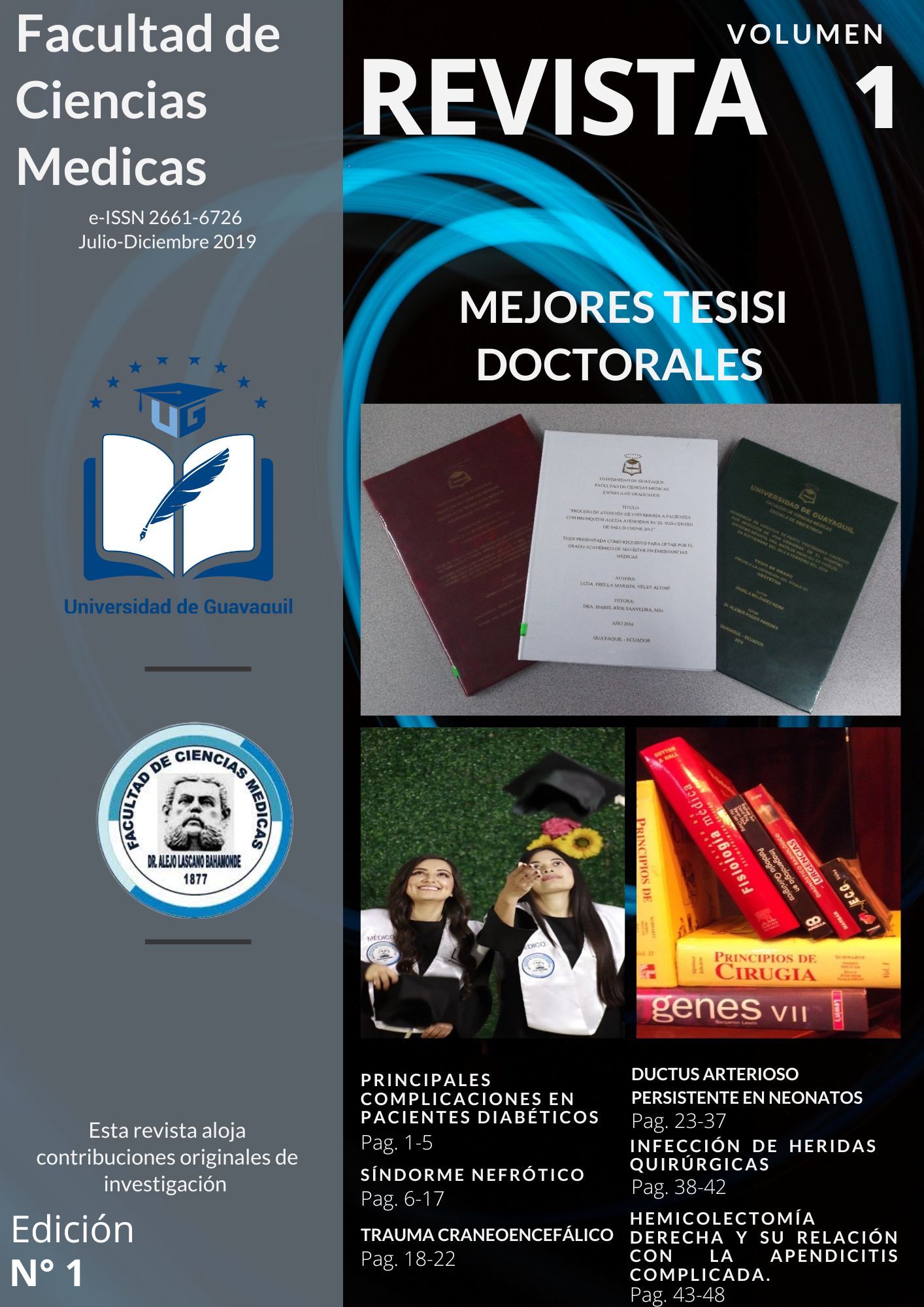Clinical and epidemiological characterization of nephrotic syndrome in patients from 2 to 12 years of age
Keywords:
Patent ductus arteriosus, patent canal arteriosus, congenital heart disease, neonates, pharmacological treatmentAbstract
The Spanish Society of Pediatrics (SEP) defines nephrotic syndrome (NS) as one of the most frequent primary glomerulopathies in pediatric patients characterized by urine protein greater than 40 mg/m2/h, hypoalbuminemia less than 2.5 g/dL and edema, accompanied by other symptoms such as hypercholesterolemia, hypertension, hematuria, and oliguria. Being edema the main clinical characteristic, NS groups a series of glomerulopathies where there are lesions in the podocytes, altering the selective permeability of the glomerular filtration barrier causing the passage of proteins.
Objective: To establish the clinical and epidemiological characteristics in patients diagnosed with nephrotic syndrome in the Children's Hospital "Dr. Francisco de Icaza Bustamante".
Method: The present research work is a retrospective, cross-sectional, non-experimental quantitative approach with a sample of 362 patients diagnosed with NS in the Children's Hospital "Dr. Francisco de Icaza Bustamante" in the period of time 2017 - 2020.
References
Gómez A, Pérez , Chaviano O. El síndrome nefrótico en pediatría: un impacto en la infancia. Revista Finlay. 2019 Marzo; 9(1).
Montell , Vidal , Sánchez Caridad, Méndez. Nephrotic Syndrome, an 18- years study. Matanzas. Mi SciELO. 2018 octubre; 38(8).
Abarca Zúñiga V, Álvarez Rodríguez N. Síndrome nefrótico en pediatría.. 2020;5(3):e392. Rev Medica Sinerg. 2020 MARZO; 5(3).
Dossier Claire, Ortiz Vera, Jamin A, Deschênes G. Idiopathic nephrotic syndrome: The EBV hypothesis. Pediatr Res. 2017 Septiembre; 81(1).
Hevia P, Nazal , Pinela Vásquez, Rosati MP, Quiroz L, Alarcon C, Márquez S, et al. diopathic Nephrotic Syndrome: recommendations of the Nephrology Branch of the Chilean Society of Pediatrics. Part One. Revista chilena de pediatría. 2017 Mayo; 4(1).
Palma Cobeña J. Síndrome nefrótico en pacientes de 1 a 12 años ingresados en la unidad de pediatría del Hospital Verdi Cevallos Balda. Rev. PO CAIP. 2017; 2(1).
Kallash M, Smoyer W, Mahan JD J. Rituximab use in the management of childhood nephrotic syndrome. Front Pediatr. 2019; 7.
Malaker R, Baquero R,Saha S, Hanif M, Ahmed A, Hasan. Invasive Pneumococcal Infections in Children with Nephrotic Syndrome in Bangladesh. Pediatr Infect Dis J. 2019; 38(8).
Cil O, Perwad F. Monogenic causes of proteinuria in children. Front Med. 2018 Marzo; 5.
P MV, T AV, JA BdlV, M RPMd, F FR, C. GR. Incremento de lipoproteína(a) en paciente pediátrico asociado a síndrome nefrótico. Clin e Investig en Arterioscler [Internet]. 2017; 28(5).
Lane J. Pediatric Nephrotic Syndrome Workup. Medscape [Internet]. 2016; 3(7).
Trautmann A VMSSGDSASFea. IPNA Clinical Practice Recommendations for the Diagnosis and Management of Children with Steroid-resistant Nephrotic Syndrome. In Nephrology and Dialisis.: Pediatric Nephrology; 2021. p. 435-473.
Ali SH ussai. AAo,NAi. The predictive factors for relapses in children with steroid-sensitive nephrotic syndrome. Saudi J Kidney Dis Transpl. 2017; 27(1): p. 67–72.
Han KH KS. Recent Advances in Treatments of Primary Focal Segmental Glomerulosclerosis in Children. Biomed Res Int. 2016. 2017 Abril; 21(3).





